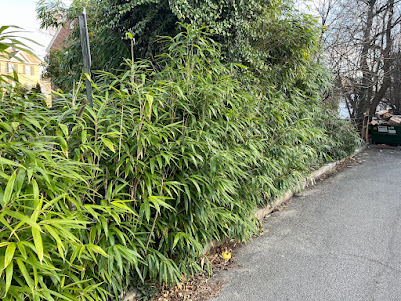This post isn't about the tall bamboo you often see growing around town. That would be golden bamboo (Phyllostachys aurea), native to southeast China, cultivated in Japan for centuries, and first introduced to the United States in the 1880s. In our neighborhood, I sometimes see people of asian descent harvesting its young shoots in the spring. (If you're looking for a clever way to get rid of it, or want to eat it, or both, scroll through my various previous posts that actually ARE about the nonnative golden bamboo.)
Nor is this post about the bamboo you are confronted with when you pull out of the Spring Street parking garage behind the Princeton Public Library. That one's probably the nonnative
arrow bamboo (Pseudosasa japonica), which lacks the towering, thick stems. Instead, it grows into a dense mop of evergreen foliage, seldom rising much beyond ten feet high. It's rarely seen in Princeton, but was a common feature in neighborhoods where I used to live, further south in the piedmont, in Durham, NC. We'd find it thriving in shade, and in that Princeton back alley it does an excellent job of screening the homes beyond it from the sight of cars pulling out of the parking garage day and night.
This post IS about what that patch of arrow bamboo reminded me of:
native bamboos. Yes, there are native bamboos that once dominated vast stretches of the southeastern U.S., but which are now largely lost from the landscape.
The photo shows a patch of native bamboo, cane so-called (
Arundinaria sp.), that I planted 20 years ago in a nature preserve we created in Durham, NC. Called "17 Acre Wood," the neighborhood preserve straddles Ellerbe Creek--good floodplain habitat for native cane. A scientist with the Natural Resource Conservation Service, Roger Hansard, had given me the plant.
(He was also the one who showed me the last remnant of another little known, long-lost feature of the eastern U.S.--extensive native grasslands. There once was a great native meadow just south of Princeton, called Maidenhead Meadows.)
Prior to western settlement, early European explorers in what is now North Carolina documented not the unbroken forest of lore, but a mosaic of grasslands, forest, and canebrakes. The canebrakes were dominated by native bamboos.
There are three species of native bamboo.
A Name That Plant article gives a quick overview of native (
Arundinaria sp.) and nonnative bamboos in the U.S..
Differences in distribution and vegetative characteristics help to distinguish among Arundinaria species and from non-native species. Typically river cane is more widely distributed in the southeastern US, switch cane in coastal plains and lower elevations, and hill cane in higher elevations (Appalachian Mountain region).
The Tennessee Conservationist has
an excellent writeup on the river cane that until the 1700s formed "the dominant ecosystem in the Cumberland River valley." Dense stands of river cane, growing from 5-40 feet tall, served as important resources for American Indians, excellent forage for bison and later cattle, and hiding places for escaped slaves. They postulate that some of these massive canebrakes were the result of cane reclaiming corn fields abandoned by "prehistoric Mississippian peoples" many centuries prior, as major droughts led to the breakup of an early civilization. In turn, the canebrakes proved easier than forests for newly arrived western settlers to turn into farm fields.
If you've never seen bamboo blooming, it's because it can grow for decades without blooming at all. Then a year finally comes when the whole patch will bloom at once, then die. I've seen a whole city block suddenly die in this way.
The cluster of roots and leaves of native bamboo that I planted alongside Ellerbe Creek some 20 years ago in Durham has grown into a patch 30 wide. Maybe someone will come along and use it as a source for replanting the Cane Creeks of the world, named for what was once abundant and now is seldom seen.
That's what I was reminded of a few weeks ago, pulling out of the Spring Street parking garage next to the public library.


No comments:
Post a Comment